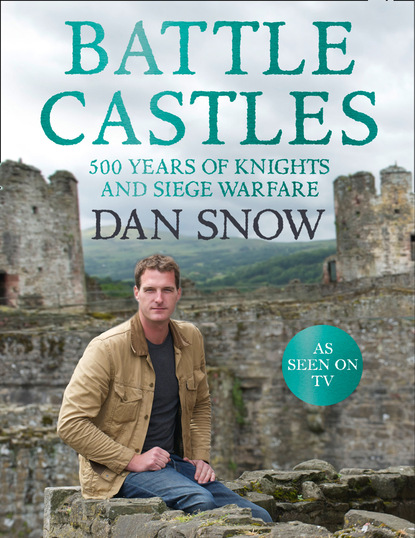
Полная версия:
Battle Castles
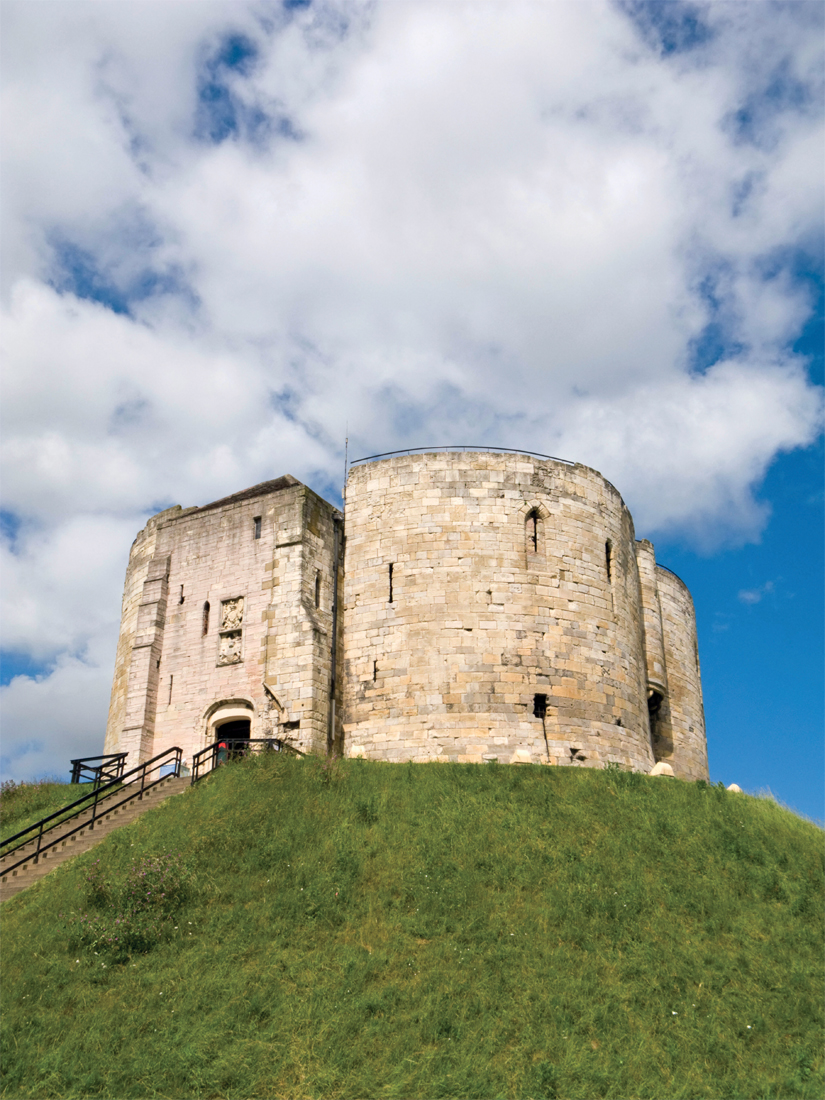
Clifford’s Tower, York. The remains we see today are thirteenth century, but the site was once topped by an earlier fortification built by William the Conqueror
© incamerastock / Alamy
Typically, William would crush the rebellion in person and then build castles to ensure a strong Norman presence right across the kingdom. These would be garrisoned by reliable allies, often relatives, who were expected to keep the peace and were allowed to enrich themselves in return. William’s biographer tells how, ‘in castles he placed capable custodians, brought over from France, in whose loyalty no less than ability he trusted, together with large numbers of horse and foot. He distributed fiefs (or landholdings) among them, in return for which they would willingly undertake hardships and dangers.’
First William had to march south-west to Exeter, where he erected a castle in the remains of the Anglo-Saxon burh. The following year he marched north through the east Midlands and East Anglia, planting castles at Warwick, Cambridge and York, among other places. Perhaps the most serious challenge came in 1069 when Edgar, the Anglo-Saxon with the best claim to the throne, invaded northern England, killed William’s lieutenant in the north and captured York, England’s second city. William sent an army north which defeated the rebels, forced Edgar into exile and punished the region heavily, salting the land to make it infertile and slaughtering inhabitants. As land and power was stripped from the English lords and churchmen who William could not trust, a small group of foreigners took over almost the entire national wealth.
Such a heist would have been impossible without castles. William continued building them at strategic points in the kingdom. He created an entire system of land ownership and obligation aimed at supporting the castle, seen as the bedrock of his regime. Land was given to knights, who in return had to serve as garrison for the nearby castle. Even tradesmen like cooks and carpenters were given places to live in return for service. On the south coast, six castles – Hastings, Pevensey, Lewes, Bramber, Arundel and Chichester – were established with a vast hinterland geared up to support them. The Welsh borders were parcelled out, as was the far north of England. Just as the Romans had fortified the coast, so too did the Normans. Whereas the Romans paid for their forts with a sophisticated central treasury and a standing army that served from province to province, Norman castles were designed to be self-sufficient. The local lord and his warriors were rooted to the land, paid not by a distant exchequer, but by the proceeds of what they could grow or acquire locally.
The power of local Norman lords meant William was not alone in building castles. An explosion in castle building followed his accession. Almost one hundred are referred to in sources before 1100, but there were many more. Across England and parts of Wales numerous surviving earthworks date from this time: 85 in Shropshire, another 36 in what used to be Montgomeryshire. John Goodall estimates that as many as 500 could have been founded in the decade after 1066 alone – some built by the king, others by the great magnates who now dominated England, and others still by relatively minor gentry, given parcels of land in reward for loyal service, their names now lost to history. This was a militarized landscape. In the words of the Anglo-Saxon Chronicle, the king and his warlords built castles ‘far and wide throughout the country, and distressed the wretched folk, and always after that it grew worse’. Often mottes were sited in positions of mutual visibility, no more than a day’s march apart, so one garrison could reinforce another that found itself under attack. Visiting these ghostly mounds today, their size much-reduced by 900 years of erosion, one should imagine the three- or four-storey towers which stood on top of them, dwarfing the small dwellings nearby, and think of the wood, earth and stone with which the Normans locked down the country.
The most powerful castle builder in the kingdom, apart from William, was his relative and childhood friend William FitzOsbern, who was given a huge swathe of land from the south coast of England up to the Welsh borders. The various Welsh peoples had maintained an ancient enmity with the Anglo-Saxons which their Norman successors now inherited. Using the river network as modern humans would use roads and rail, FitzOsbern built castles, large and small, across the shifting frontier zone at places like Berkeley, Wigmore, Clifford and Monmouth. He is remembered for the stunning castle at Chepstow, sitting proud on towering cliffs, dominating the sweeping bend of the River Wye. To visit it today is to feel like you are entering a royal palace, and it may in fact have been just that. When FitzOsbern was killed on campaign in Flanders in 1071, the site reverted to King William, and it may have been William who built a palatial fortress on his Welsh border. Tellingly, it is built on the Welsh side, sending the lords of Gwent an unambiguous signal. As in Colchester or London, further clues into the Norman mindset are built into the fabric of the castle. A crumbling Roman fort nearby was looted for bricks, which were incorporated into the walls. William was embracing physically and symbolically the Roman imperial legacy. He was a new Caesar, locking barbaric Britain into a civilized empire. A new imperial project was born, and castles were its symbol.
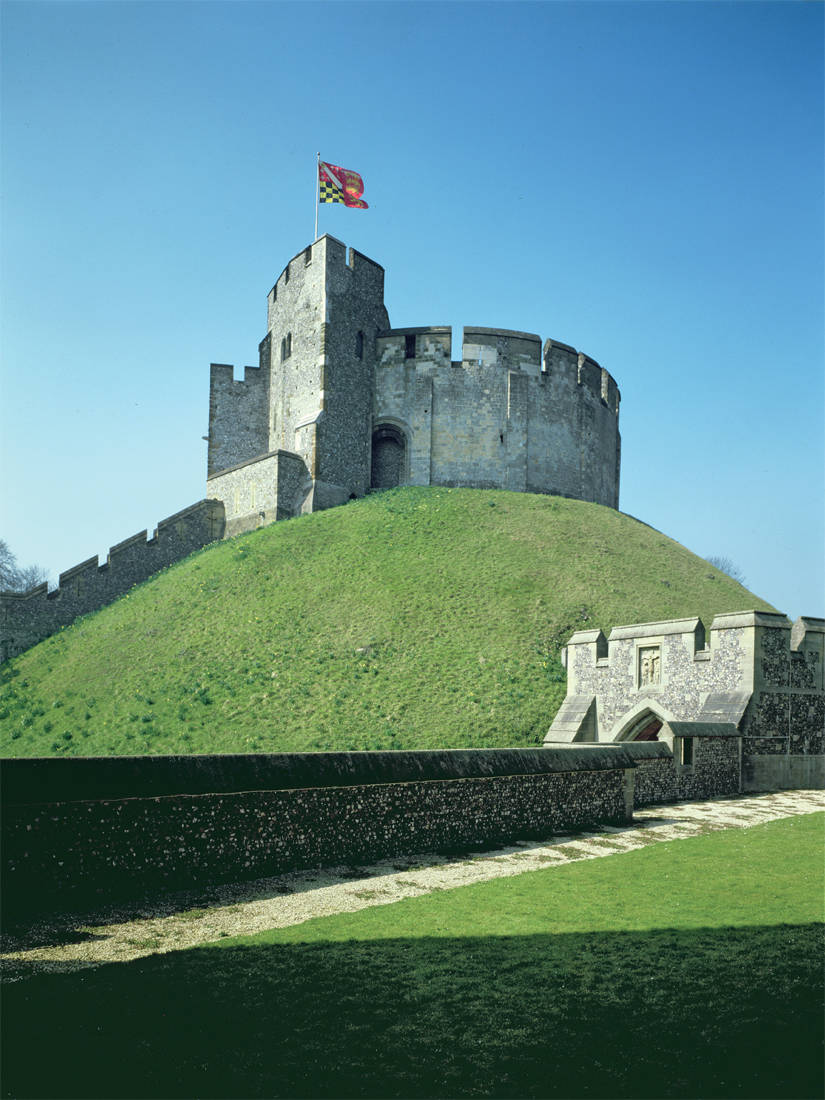
The shell-keep of Arundel Castle which was built in the twelfth century. The design is of the motte-and-bailey type, but the masonry used is much stronger and more durable than timber
His Grace The Duke of Norfolk, Arundel Castle / The Bridgeman Art Library
What these castles did was make it possible for around 7,000 men to pacify a country of two million people: they were the most efficient ‘force multiplier’ available in this period. This, it has always struck me, was the true reason behind their sudden supremacy. Castles burst onto the scene in medieval Europe not as expressions of strength but of weakness. They were the tool of small-scale imperial powers, such as William’s Normans, who commanded only relatively minor forces. When the Romans invaded Britain 1,000 years earlier, they did so with some 20,000 legionaries and a similar number of auxiliary troops – a massive army which was much larger than the numbers at William’s disposal. While the Romans were able to find and annihilate in battle every British army that gathered against them, William’s forces needed castle walls to shelter them from the English weight of numbers. The sources are full of accounts of Normans hunkering down and simply waiting for rebellions to subside, before sallying out to hunt down the ringleaders and punish the population. The most balanced account of the Conquest is the Ecclesiastical History written by the monk Oderic Vitalis, who had a Norman father and an English mother. His assessment of how the Normans annexed what had been the most powerful state in Western Europe was simple: ‘The king rode to all remote parts of his kingdom and fortified strategic sites against enemy attacks. For the fortifications called castles by the Normans were scarcely known in the English provinces, and so the English – in spite of their courage and love of fighting – could put up only a weak resistance to their enemies.’
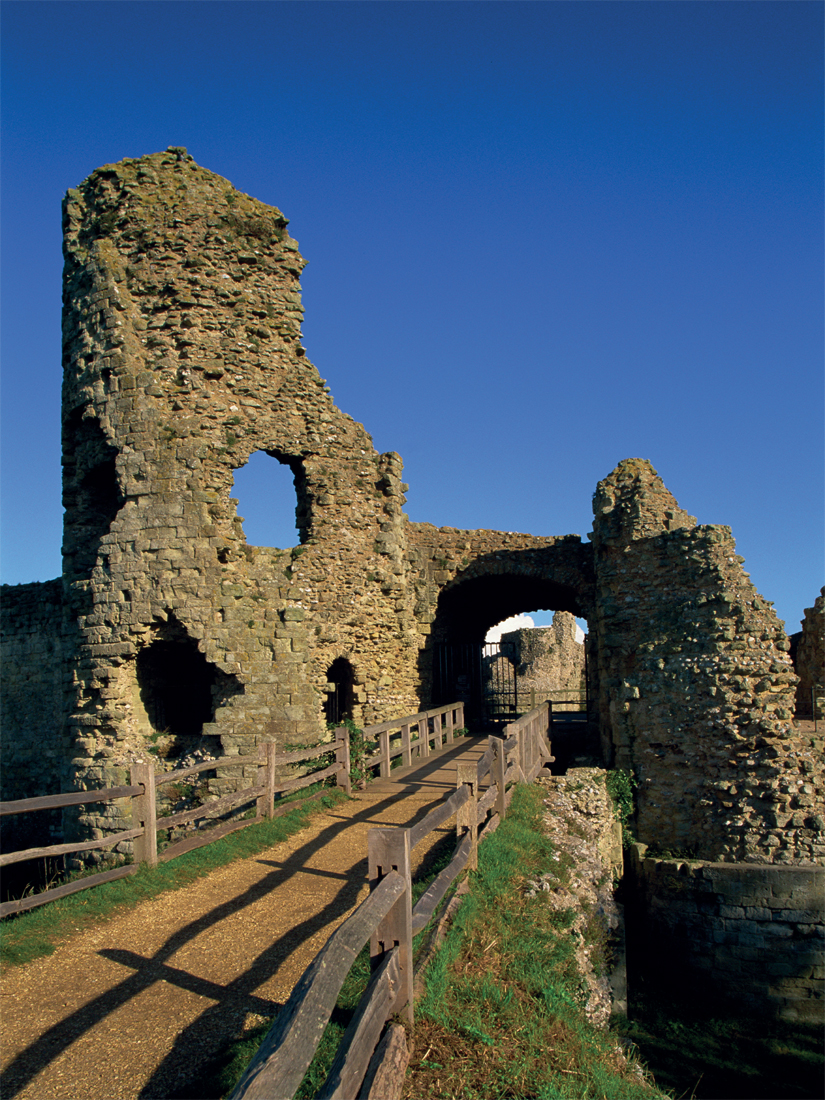
Pevensey was one of the first sites to be fortified when William the Conqueror came to England. Under the Normans it was updated to include a stone keep
Robert Harding World Imagery / Getty Images
Rarely in history has an annexation proved so enduring. The Norman grip on England held strong and Norman influence and power slowly spread, with varying success, through Wales, Scotland and Ireland. By the twelfth century, one chronicler referred to castles as ‘the bones of the kingdom’. But the warlords with their mighty castles that underpinned this dominance brought their own problems. Castles had begun as a response to the breakdown of central control, and a lord in his castle was a king in his own domain. To live in a castle bred, and still breeds, an independence of spirit, a suspicion of distant rulers or central government. Conquest and occupation was led by an active warrior king, but it was often enforced by a patchwork of local, autonomous warlords. To a king of William’s stature this was not a problem, but to his successors, castles, and the men who guarded them, would often prove less like bones that gave kingdoms their integrity, and more like rocks on which the ship of state could founder.
William’s descendants would learn that castles were loyal only to the men who held the key to their gate. His son, William II, was immediately faced with a rebellion by his father’s greatest nobles, who preferred the prospect of his brother’s rule. He was forced to conduct a gruelling siege of Pevensey Castle, once the symbol of his family’s claim to the English throne, as well as sieges of other castles, before a mixture of generous promises and the non-appearance of his brother’s army allowed him to secure the throne. Castles were the weapons of occupation, but not the tools of orderly royal rule.
Across Europe similar trends were seen. As the principalities of Western Christendom chipped away at the ring of pagans and Muslims that surrounded them, they built castles on their expanding frontier zones. Against the English, William the Conqueror had believed himself to be on a Crusade, carrying the Pope’s banner into battle. The Pope encouraged this, knowing that the English Church was frustratingly insubordinate. In Iberia, the Baltic and Eastern Europe, relatively small Crusader forces would annex land and then lock it down with a network of castles exactly as William had done in Britain. The Christian toehold in the north of the Iberian peninsula, initially part of the Frankish kingdom, first broke away from French control and then became a base for the conquest or ‘reconquest’ of the rest of modern Spain and Portugal. In Catalonia, in the far north-east, the massive castle of Cardona and the magical Quermançó Castle, built in the late eleventh century on a dizzying rocky outcrop, are testament to a refusal to be dominated by their neighbours – Christian or Muslim. Further south, the sprawling central area that would become the Kingdom of Castile was so defined by castle building that its very name was derived from them. Desperate to cling onto their gains, Crusaders built castles relentlessly – and their Muslim opponents did too. At Málaga, on the peninsula’s southern coast, the great castle of Gibralfaro – clinging to a hill above the town – would prove one of the last bastions of resistance against the resurgent Christian armies (see Chapter 6).
Other Christian Crusaders pushed north and east. The warlike Normans travelled widely, building castles as they went. As William was crossing the Channel, his countrymen travelled also to southern Italy, first, it seems, as religious tourists, then as land-hungry warriors. Men like William de Hauteville, who won the nickname ‘Iron Arm’, arrived as adventurers and died as sovereigns. His half-brother Robert invaded Sicily and built San Marco d’Alunzio, the first Norman castle there, before capturing Rome itself.
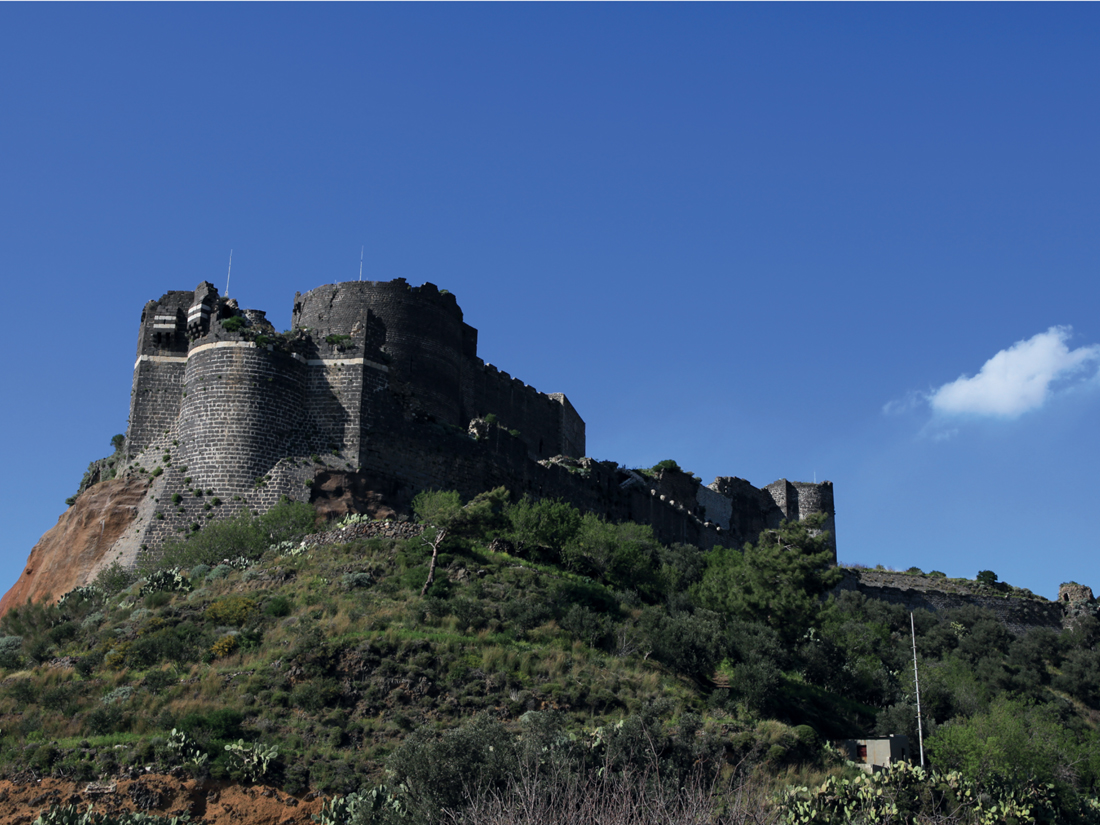
Margat Castle’s black walls contrast starkly with the white limestone of Krak. Built of hard basalt, it was one of the Knights Hospitallers’ most important strongholds
In November 1095 Pope Urban II proposed a military expedition to ‘recover’ Jerusalem, the holiest site in the Christian faith – a call which unleashed wars of terrible ferocity across Eastern Europe and the Middle East. Kingdoms and principalities were carved out, besieged, captured and recaptured. In what was already a heavily-fortified landscape, the Christians built the most perfect castles in the world: Kerak, Krak des Chevaliers, Marqab and Saone to name a few (see Chapter 3). To visit them today is a truly awesome experience. At Saone, now known as Salah Ed-Din’s (Saladin’s) Castle after the Egyptian military genius who eventually captured it, there is a 30-metre-deep ditch cut into the rock either by the Crusaders or their predecessors, guarded by a monumental Crusader bastion with walls 5 metres thick. As I approached these castles, panting in the heat, the walls seemed to grow ever more formidable. I was overwhelmed by the lengths to which the Crusaders went to protect their conquered territory. But I also could not help thinking that these vast edifices bear witness to the fury and vigour with which the Muslims tried to drive them back into the sea.
With a supply chain stretching over thousands of miles, a hostile unfamiliar climate and a dizzying array of enemies close by, these castles were needed as ‘force multipliers’ more than anywhere else. Despite the utterly different terrain, they were doing the same job as castles everywhere else I had visited. A group of armed outsiders, invaders, surrounded by hostile territory, sought refuge and strength behind stone walls, gatehouses and towers. The process was universal. I saw the same thing in Syria that I had in Wales, France and Spain.
In the West, war and anarchy continued to promote the building of castles. When King Henry I of England dared to die without a male heir, despite having fathered over twenty acknowledged illegitimate children, England was again plunged into chaos. Camps formed around his daughter Matilda and her cousin Stephen. War followed. Local lords looked to their own defence. Fortifications were raised. ‘Christ and all his saints were asleep,’ a chronicler observed, and ‘the land was filled with castles’.
Castles appear to have made civil war all the more intractable. Neither side had the resources to besiege their enemy’s castles one after the other and so two competing weak regimes were eclipsed in the provinces by local powerbases. For the first time in British history, sieges really came to the fore. During a siege of Newbury Castle, Stephen demanded the surrender of the garrison and said if they held out he would hang the son of their defiant leader in broad view. The warlord defied this threat: ‘I still have the hammer and the anvil,’ he declared, ‘with which to forge still more and better sons!’ Fortunately for the child, and fortunately for England, Stephen did not carry out his threat. The boy, William, would grow up to become the supreme English knight of medieval history, the Marshal of England and saviour of the kingdom at its lowest ebb. Matilda herself was no less lucky if folklore is to be believed. Twice she escaped from being besieged, once across the frozen Thames in winter in a white cloak, and once as a corpse being taken out for burial.
The so-called ‘Anarchy’ came to an end when Matilda’s son Henry Plantagenet invaded England from France in 1153, and forced the ageing Stephen to negotiate. The death of Stephen’s heir opened the door to a deal and Stephen named Henry as his successor. Through his marriage to Eleanor of Aquitaine, Henry II would control a vast empire from the borders of Scotland to the Pyrenees. To secure it he tore down troublesome castles and built mighty royal ones, like that at Dover which rose above the white cliffs and which would endure the attacks of Prince Louis, another claimant to the throne of England (see Chapter 1).
Henry spent vast amounts of money on his royal castles. It was not unusual for half the annual royal budget to be spent either on building new castles or repairing old ones. An eyewitness observed of the building work at the Tower of London that ‘with so many smiths, carpenters and other workmen, working so vehemently with bustle and noise […] a man could hardly hear the one next to him speak’. Under Henry we know that an unskilled labourer moving earth and stones on a site like this would have been paid a penny a day. For the King these castles were about prestige as much as security. Dover was a glittering adornment to the channel coast, visible to ships passing through the narrows, a symbol of Henry’s massive empire. It was also one of many seats of government. Medieval kingship was peripatetic: kings and courts moved constantly. Since rule was personal it was wise for a king to show himself to his subjects, dispense justice and redress grievance as widely as possible. But logistics also played a part. The King and his court soon consumed all the supplies in one castle and it was easier to move to the food than to bring the food to them. Henry would have recognized the description of medieval kingship offered by his namesake, Henry IV, King of France: ‘I rule with my weapon in my hand and my arse in the saddle.’ His royal castles really were residences for him and his court on these huge progresses and they were appointed with all the finery demanded by the royal court.
The castles also served their most obvious purpose. When Scottish King William the Lion invaded England in 1173, he marched on Newcastle but did not even attempt to besiege the castle because he lacked the necessary, cumbersome siege engines. When he tried to besiege Alnwick, he was captured by English knights and eventually forced to sign a humiliating submission to the English Crown. Henry’s castles defended his northern frontier while he focussed his attention on unrest in other parts of his empire.
That empire grew wider: Ireland was sucked into the orbit of the Plantagenet Crown when Henry himself invaded and captured Dublin, and received the submission of its bishops and kings. Castles like Kilkenny, Killeen and Dunsany were planted by Henry’s subordinates, and his son, John, started work on Dublin Castle, a building that was to remain the seat of English and then British rule in Ireland until 1922. Ireland remained largely beyond the writ of English government, however, as other targets distracted English kings. It was never fully annexed, the chronicler Gerald Cambrensis lamented, because of the failure to build castles ‘from sea to sea’.
Henry’s sons utterly failed to guard their vast inheritance. Richard was a warrior, but no ruler, and John may have been a ruler, but he was no warrior. Richard died while pressing home the siege of a castle in France. His younger brother John’s reign saw Philip of France pushing to expand his kingdom at the expense of Plantagenet lands – laying siege, most notably, to Château Gaillard, the extraordinary castle Richard had built above the small town of Andely, on a bend of the River Seine (see Chapter 2). Failure and losses in France led to unrest in England itself, where rebels tried vainly to hold out in Rochester Castle (‘Living memory,’ a chronicler wrote, ‘does not recall a siege so fiercely pressed, and so staunchly resisted’). The French intervened in this English civil war and the loyal knight Hubert de Burgh led King John’s garrison at Dover in defiance of Prince Louis’ invading army (see Chapter 1).
The years following the death of Henry II witnessed a protracted struggle about the nature and limits of kingship, and castles were the physical manifestation of an aristocracy that felt themselves more than simple subjects. John, his son Henry III and even Henry’s warrior son, Edward, were no strangers to being besieged and even captured by rebels. Eventually the monarchy, in the person of Edward I, emerged victorious, but only after he had promised to abide by the restrictions placed on his grandfather and father by the Great Charter or Magna Carta.
Edward’s peace within England lasted long enough to turn his attention to unfinished business in the rest of the British Isles. Edward fought several campaigns in Wales, initially punitive but eventually of outright conquest. As always, castles were to be the method of subjugation. Edward spent a staggering £80,000 in twenty-five years, considerably more than his father had spent on the magnificent Westminster Abbey. Edward’s engineers built castles that are regarded around the world as some of the finest ever built, including Harlech, Caernarfon, Beaumaris and Conwy – a ring of steel around the recently-independent mountain region of Gwynedd in north-west Wales. To this day, a castle like Conwy dominates its surroundings. Caernarfon was built on a site with powerful Roman associations, and in its architecture and brickwork it deliberately echoed this earlier empire. This was Edward staking his claim to be the modern incarnation of the Caesars, just as his ancestor William had done centuries before. The Welsh understood the message, and when they rose in rebellion, it was these castles – symbols of hated English rule – that were a prime target (see Chapter 4). King Edward attempted to bring Scotland and Wales under the English Crown and yet again castles were used to enforce occupation. Scotland already had a wide network of castles built by Anglo-Norman settlers who had integrated themselves at the Scottish court through marriage and service to the Scottish Crown. These castles Edward sought to control as his forces dealt with widespread rebellions across the countryside led by William Wallace and Robert the Bruce. The Bruce knew just how important these castles were and rarely lost a chance to ‘slight’ or render them defenceless by collapsing an important section of wall. Scotland was never truly pacified by Edward, who died on his way north to deal with the latest of the Bruce’s victories.
As the chapters in this book explain, the design for these castles had evolved greatly since the arrival of the Normans in England. The key defence was no longer, as at Dover, a central keep, but the outer layers. Towering walls, lofty round towers and a massive gatehouse were in vogue, allowing the interior to be laid out with palatial magnificence. The gateway had always been a weak point, but by the thirteenth century changes had made it almost the strongest point of the castle. Round towers on either side in castles like Framlingham in Suffolk or Caerphilly in South Wales were pushed forward with embrasures, allowing the defenders to rake the entrance with crossbow bolts and arrows. Above the gate murder holes and ‘machicolations’ could be used to pour boiling water or incendiaries on the attackers below. Some castles were given a barbican or additional defensive layer in front of the gates, which might be offset to prevent an attacking force using a battering ram.
Scotland eventually secured independence thanks to a crushing victory at Bannockburn in 1314 in the shadow of Stirling Castle, held by the English, besieged by the Scots, and the key to central Scotland. Castles played a huge role in the nature of Scottish kingship thereafter. A geographically-disjointed state with a poor central treasury, Scotland had little choice but to delegate political authority. Lords ruled isolated areas with the powers of kings. Castles were the choice of these aristocrats, partly because Scotland was occasionally torn by civil strife (although it does not seem to have been endemic as was once thought), but partly also because of fashion. The Bruces, the Comyns, the Balliols all had Anglo-Norman blood, owned land in England, and employed the same architects and engineers as their peers had south of the border. Their castles reflected their status as demi-kings: in their own lands dispensers of justice, collectors of revenue and protectors.
Further north the kings of the Scots pursued their own imperial project, with the same vigour with which they defended their independence from the English. James IV fought long and hard to bring north-west Scotland under the control of Edinburgh. One of the most iconic castles in Britain, Urquhart, teetering on the edge of Loch Ness, was strategically vital and constantly changed hands between the Scottish Crown and the Lords of the Isles who dominated the north and west highlands of modern Scotland.
Eastern Europe, meanwhile, became a giant frontier between Christendom and the pagan, often nomadic, tribes of the steppes. The ‘Teutonic Knights’ who began operating in the Crusader States of the Holy Land pursued God’s enemies instead in the north-east of the continent, helping to convert (and conquer) Prussia on the Baltic coast. Behind them they left towering castles in red brick – strongholds like Malbork, which allowed them to dominate the region and to grow rich off its trade (see Chapter 5). The German brickmakers and engineers that they used were some of the most proficient in Europe, and further west, in Germany itself, it was said that there was a castle to every square mile, helping to frustrate the ambitions of anyone who sought to unify the hundreds of autonomous statelets, bishoprics, margravates, duchies, and the like which covered central Europe in a bewildering patchwork.



